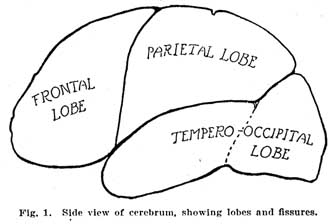
HOME HYGIENE LIBRARY CATALOG TABLE OF CONTENTS
One of the fundamental principles of the philosophy of Natural Therapeutics is the unity of disease. This means that all the various forms of disease arise from a few primary manifestations, namely, lowered vitality, abnormal composition of vital fluids and accumulations of morbid waste and systemic poisons in the organism. It remains for us to explain why it is possible that in the same kind of an organism a great variety of diseases can arise from a few primary abnormal conditions. To this we answer, it is the organism which is infinitely complex, not the disease. Man, not his disorders, is the great study.
Since a few primary causes or manifestations of disease may produce an infinite multitude of symptoms, it is impossible to accurately diagnose the underlying disease from external symptoms. Therefore, basic diagnosis does not attempt the diagnosis of symptoms, but aims at the diagnosis of the patient.
When we understand the organism, the functions and interdependence of its parts and organs, disease offers but a simple problem.
All men are not alike. All men do not function alike. They are alike only in general anatomical structure--only in crude form or mould. Man is not altogether a machine operating on mechanical principles. Closely allied with the mechanical structure, and controlling it, are the vital or psychical and the mental or intellectual principles.
The numerous functions of the human body may conveniently be classified under three main groups, namely, respiration, alimentation and generation.
Respiration is that function which takes care of the oxygenation of the blood and the elimination of burned carbonaceous materials through the lungs. As explained in Vol. II of this series, in the chapter dealing with correct breathing, respiration is the function on which depends the inflow of the dynamic force or life force necessary to maintain the vital activities within the body.
Alimentation is that function which enables the body to digest and assimilate the proper quantity and quality of food, and which removes the residue of such processes from the body.
Generation is that function which assures perpetuity to the human race by means of reproduction. The secretions of the ductless glands of the generative organs are necessary to the maintenance of the vital activities of the organism.
Back of these three basic functions of the human organism lie three corresponding life principles--the physical material principle, the mental or intellectual principle, and the psychical or moral principle.
The material principle stands for substance, solidity, physique, and is closely allied to the terrestrial plane. This principle is in sympathy with physical nature, and its nerve mechanism--the great sympathetic--is the instrument through which the life force controls animal functions.
The one who possesses a large proportion of this principle is hardier, stronger and more robust than those individuals in whom either the mental or psychical principle predominates.
The psychical or moral principle connects us with the Psyche or Soul of the universe. Through the psychic principle the individual consciousness receives an influx of intuitive intelligence and creative will from the great universal creative Intelligence which some call God or Nature, others Cosmic Intelligence, Creative Will, Over-soul, Brahm, and by many other names. The psychic "wireless" is therefore the source of inspiration and illumination; it makes possible the apprehension of abstract truth,--of time and space, of right and wrong. It is the "light that lighteth every man that cometh into the world".
Consciousness is the passive capacity of the individual intelligence, soul or ego. It receives impressions and impulses from two sources--from the physical material surroundings through the sensory organs, and from the immaterial psychical world of laws and causes through the psychic principle. Through the psychic wireless it receives an influx of intuitive intelligence and creative will. This innate intelligence senses, observes and compares the sensory impressions and sensations, and discriminates between them. It classifies the contents of consciousness and from them draws conclusions and judgments. Thus originates and grows the reasoning mind. From this it will be seen that the mind is that principle which stands between and connects the physical and psychical principles, and that we create it ourselves.
The mind has been likened to a circle, the center of which is the ego and the circumference of which may be anywhere in the universe. In the new born infant or in the idiot its diameter is exceedingly limited, while in the great scientist or philosopher it may fathom the secrets of the starry heavens. It does not reach full completion until it embraces all there is to be known in the sidereal universe.
Its expansion depends upon the number and variety of sensory impressions and impulses received from the physical or spiritual (material) surroundings and upon the amount of thinking, reasoning and philosophizing brought to bear upon the contents of consciousness. These psychological phonographic and photographic films constitute memory and the subconscious mind of the psychologists and occultists.
Sensory impressions and impulses from without and the thinking and reasoning from within, give rise to sensations, emotions, impulses and desires which, in turn, call forth the activity of the will. The will in action is volition.
What nerve specialists and psychologists call the reflex arc consists of this twofold function of receiving and giving, which underlies all the activities of human life. The balancing of receiving and giving constitutes physical health as well as intellectual, moral and social health.
Violations of Nature's laws in all domains of life and action involve the violation of this basic principle of giving and receiving which is the law of compensation in operation. On it depends the preservation of energy; it is the basis of civil as well as of ethical and moral law. Only by complying with its demands can we solve the social problem.
Reason and common sense should tell us that the relationships of human life must be under the control of natural law as well as the relationships of numbers, of atoms of matter and the harmonics of sound. This is true notwithstanding the assertion of materialistic philosophy that there is nothing innately settled and permanent about ethics and morals, that they are subject to change and custom like fashions in hats, frocks and walking canes.
From the foregoing it becomes apparent that the mental or intellectual principle comprises the faculties which constitute the reasoning or objective mind, such as observation, discrimination, calculation, deduction and logic. It harbors the executive qualities and prompts voluntary action. It is a thinking apparatus and, in itself, is cold, calculating and exact. It is the scat of judgment apart from sentiment and feeling, and moderates the qualities of sympathy and mercy.
The reasoning or objective mind deals only with facts and data gathered from observation and experience. This is in agreement with materialistic and monistic science and philosophy; but these systems leave out of consideration that which makes thinking, reasoning and philosophizing a possibility, namely, the psychic principle. "While studying and explaining the phenomena of life, they try to exclude life itself from the scheme of things.
In the limited space of this treatise I can deal only very briefly with the relationships between the intellectual and psychic principles and the brain and nervous system. I have elaborated this in detail in Vol. IV of this series, dealing with natural eugenics.
In the following we shall trace the relationship of the three basic principles to the physical organism. The three basic principles of the human entity herein described sustain a definite relationship to the three principal divisions of the great brain or cerebrum, and through these to the three basic functions of the organism already described. It should be understood that these correspondences or relationships have nothing to do with the location of phrenological centers. Long continued careful observation and practical experience have revealed the fact that the three main divisions of the cerebrum and the three basic functions of alimentation, respiration and generation are closely allied and interdependent.
The cerebrum is divided into two hemispheres, occupying the greater part of the cranial cavity which is formed by the union of the bones of the skull. Bach hemisphere is divided by deep fissures into three separate portions called lobes. They are named according to their location in reference to the bones of the skull which form their outer protection, as follows: the occipito-temporal lobes, the parietal lobes and the frontal lobes. The occipito-temporal lobes are the seat of the material or the physical principle; the parietal lobes are the seat of the psychical or moral principle, and the frontal lobes are the seat of the mental or intellectual functions. The following illustration will serve to show these different areas of the brain.

The degree of development in the various brain areas will determine the relative strength of the three basic principles in any one individual. For instance, an individual possessing the greatest brain development in the occipito-temporal lobes of the brain is of the physical type, while an individual with a high, straight, prominent forehead with the greatest brain development in the frontal lobes, is placed in the intellectual class. The individual who has his greatest and best brain development in the parietal region, or at the topmost portion of the head, belongs to the moral class.
The classification of individuals in this manner makes it possible to determine the relative strength of the various organ systems. The three main organ systems are the digestive, respiratory and generative, and there is a direct correspondence between the brain development and the strength of the three basic physiological functions.
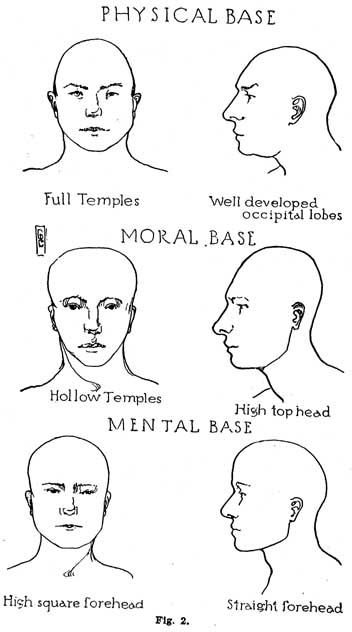
Good development in the physical brain region (occipito-temporal lobes) establishes the fact that the individual possesses strong digestive action. The development of the moral portion of the brain (parietal lobes) determines the strength of generative action, while the degree of development in the mental portion of the brain (frontal lobes) will determine the strength of the respiratory action.
The ideal human being, of course, would be the one in whom these three principles were balanced; or in other words, in whom the mental, moral and physical portions of the brain were equally developed. Such individuals, however, are of rare occurrence. The more nearly equal these three principles are in development and vitality in any one individual, the more perfect he is--mentally, morally and physically.
No person today could be totally lacking in any one of these principles without being marked as a defective. If the physical principle is very weak he will not survive infancy. If the intellect, or the frontal lobes, are only slightly developed he will be an idiot. If the psychical or moral area is undeveloped the individual lacks intuition and imagination, and is therefore limited in inventive and creative ability. Such an individual is lacking in the intuitive perception of moral, ethical and religious principles. If, on the other hand, the psychical principle greatly predominates over the intellectual the individual tends to emotionalism, is negative and subjective to outside influences and becomes an easy prey to hypnotic and mediumistic control.
Every individual must possess the three basic qualities to some degree, and the proportion of them determines not only the individual's habits and characteristics, his likes and dislikes, and his general temperament, but also his susceptibility to abnormalities and diseases of one form or another.
That portion of the brain which shows the greatest development in any one individual is called the "base", while the other two weaker areas are called the "inclinations", the stronger being the "first" and the weaker the "second" inclination.
The greater the development of the inclinations the more difficult it becomes to determine the base. The base is there, however, and is the foundation on which the individual is built. The base has a definite value, and the inclinations are relative to it. The latter may both be very weak or they may both be strong, or one may be strong and the other weak. All degrees of development occur; no two individuals are exactly alike. Where both inclinations are of a low degree of development, the base is more pronounced by contrast.
As we have shown, each principle has its particular correlated group of organs and functions in the body. These are known as the fundamental organs, and the organ which corresponds to the individual's basic principle becomes his basic organ. For example, if an individual be physically based, his basic organ is the liver, which is the principal organ of the digestive system. The liver in that individual is the strongest organ in his body, and is the one on which he depends to the largest degree for his support.
In a morally based individual the generative organs are the strongest; while in a mentally based individual the lungs are the organs upon which that individual depends for his main support.
There is no limit to the combinations that can be made with these three principles, any more than there is a limit to the number of shades that can be derived through the mixture of the three basic colors, red, blue and yellow. By determining as nearly as possible the base of an individual and the relative strength of his inclinations, we are able to gauge his individual index.
By individual index we mean the relative degree of activity on the part of the three principal organ systems under normal conditions. So, for example, the individual who is materially based with a first moral inclination and a second intellectual inclination, is strongest in the digestive organs. His greatest weakness lies in the lungs, while the generative organs are intermediate.
From this it follows that disease processes will manifest first in the weakest organ or group of organs which belong to the second inclination. Next to succumb will be the organs of first inclination. The chances for recovery are good as long as the basic organ and its aids are in fair condition and able to compensate for the weakness and deficiencies of the organs of first and second inclinations. When, however, the organism becomes weakened and diseased at its base or foundation, then the superstructure will soon give way and succumb to nature's destructive processes.
Thus basic diagnosis aids the physician to locate the organs of least resistance and thereby the seat of disease, as well as to estimate the chances for recovery. For instance, as long as a person with a strong physical base is endowed with good digestive power and assimilation, disorders of the respiratory and generative organs will be easily overcome, but when the liver, stomach and intestines of such a person become seriously affected by degenerative processes, then destruction in the lungs or kidneys will soon result in fatal termination.
Thus basic diagnosis enables the physician to express a more accurate opinion as to whether the case will improve, or whether the individual will continue to decline. It also enables him to determine which organ system needs the greatest attention from a therapeutic standpoint.
Correspondences Between Brain Areas and Organic Functions:
Occipito-temporal lobes (lower portion of cerebrum)-- digestive system.
Parietal lobes (top portion of cerebrum)--generative system.
Frontal lobes (front portion of cerebrum)--respiratory system.
It is only in rare cases and in exceptionally well developed individuals that we find all three brain regions and consequently all three organ systems developed to an equal degree and capable of exercising the same degree of function. In the vast majority of individuals at least one of these organ systems is markedly weaker than the other two. When disease begins to affect such an individual it is this weaker group of organs which first begins to manifest changes in function and ultimately in structure. To describe all the changes as they occur and the manner in which a disease process progresses, and how and why it is reflected from one part of the organism to another, would require the writing of a special volume on this subject alone. To prove these facts would necessitate the recitation of the life histories of a long list of cases from which these statements have been verified. Enough has been given to enable the physician and the intelligent layman to continue the study of this interesting subject and to profit by its practical application.
To recapitulate: As a disease process develops, the resistance of the weaker organs is broken down first and the condition is then carried to the next stronger group of organs, and finally to the strongest or basic organ. When the disease process reaches the basic organ, the individual has entered upon the last stages of pathological change. If the disease process continues unchecked the individual will finally succumb as disease destroys his stronghold.
In the following illustrations only the general types of individuals will be considered. There are six general types classified according to their base and inclinations. The base represents the strongest system; the first inclination, the system of intermediate strength; the second inclination, the weakest organ system.
1. General physical type.
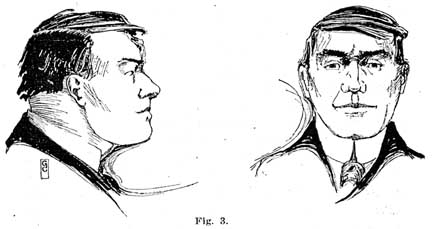
(A) Base, physical, first inclination, moral; second inclination, mental.
Strongest organs, digestive; basic organ, liver.
Intermediate organs, reproductive (generative glands and system of ductless glands).
Weakest organs, lungs.
Prominent symptoms and preliminary healing crises: Those emanating from the generative organs and the ductless glands (thyroid, suprarenals, pituitary) in cases where the disease changes have not yet reached the basic organ.
Diseases likely to prove fatal if not checked in time, or if improperly treated, are those producing destructive changes in the digestive organs, and in the liver--diabetes, cancer of the liver, cirrhosis of the liver, and advanced Bright's disease.
Early symptoms of failure of the liver manifest themselves in the form of rheumatism, which may be reflected to the heart.
Prognosis: Good, in cases where destructive changes have not yet occurred in the liver. In other words, where the principal symptoms are in the intermediate organs and the liver is still capable of compensating for the functional failure of other organs, this individual still has a chance to retrace his steps and recover his health under natural treatment. In this case the liver, in its endeavor to compensate, may increase its activity to such a degree that symptoms will arise. These symptoms, however, are functional and should not be considered alarming. It is only when the liver's function begins to fail, due to destructive changes in that organ, that the prognosis becomes rather grave.
Treatment. General natural therapeutic treatment and such natural methods as can be directed especially to the liver for the purpose of relieving it of work or of increasing its functional activity, the first purpose being to maintain compensation in the basic organ. The most vitally essential part of such treatment consists of periods of rational fasting, interspersed with periods of strict eliminative diet until the liver has had opportunity to cleanse the blood stream of surplus waste products.

(B) (Fig. 4.) Base, physical; first inclination, mental; second inclination, moral.
Strongest organs, digestive; basic organ, liver.
Intermediate organs, lungs.
Weakest organs, reproductive and system of ductless glands.
Prominent symptoms and healing crises: Those emanating from the respiratory organs, in cases where the disease changes have not yet reached the liver.
Diseases likely to prove fatal. Same as Type 1 A. .
Prognosis, same as Type 1 A.
Treatment, same as Type 1 A. -
2. General moral type.
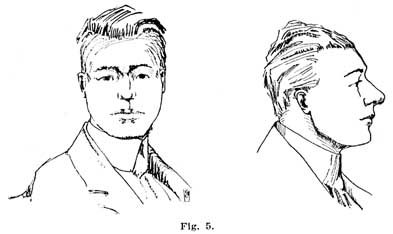
(A) (Fig. 5) Base, moral; first-inclination, physical; second inclination, mental.
Strongest organs, ductless glands; basic organs, generative or reproductive. .
Intermediate organs, digestive.
Weakest organs, lungs.
Prominent symptoms and preliminary healing crises: Those emanating from the digestive organs and liver.
Diseases likely to prove fatal: Those producing destructive changes in the generative organs, which result in degenerative changes in the system.
Prognosis: Good, unless destructive changes have occurred in the generative glands.
In individuals of the moral type, functional symptoms manifest themselves in the nervous system as a result of increased activity in the ductless glands. This is largely due to the endeavor of these structures to compensate for deficiencies in the intermediate and weakest organs. It is when this compensatory action begins to fail and destructive changes are noticeable in the nervous system that the outlook becomes grave.
Treatment. General natural treatment directed particularly to the generative organs for the purpose of maintaining compensation. A strict eliminative diet must be adhered to and occasional fasts of from three to seven days' duration. Sun baths should be employed with the sun's rays directed to the pelvic region. The remainder of the body should be protected during this specific treatment. Such a sun bath should not be prolonged above fifteen minutes. The vital fluids of patients of this type must be conserved, consequently there must be total abstinence from sexual intercourse during the period of their cure.
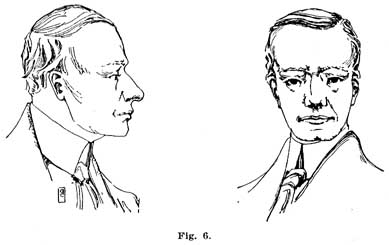
(B) (Fig. 6.) Base, moral; first inclination, mental; second inclination, physical.
Strongest organs, ductless glands; basic organs, generative.
Intermediate organs, respiratory.
Weakest organs, digestive.
Prominent symptoms and preliminary healing crises: Those emanating from the respiratory organs, in cases where the disease changes have not yet reached the ductless glands and the nervous system.
Diseases likely to prove fatal, same as Type 2 A.
Prognosis, same as Type 2 A. Treatment, same as Type 2 A.
3. General mental type.
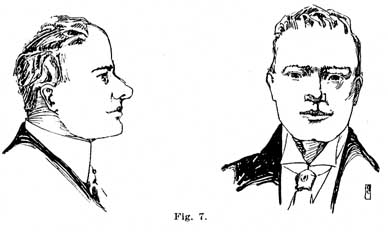
(A) (Fig. 7) Base, mental; first inclination, physical; second inclination, moral.
Strongest organs, lungs; basic organ, upper lobes.
Intermediate organs, digestive.
Weakest organs, ductless glands.
Prominent symptoms and preliminary healing crises: Those emanating from the digestive organs, in cases where destructive changes have not yet occurred in the lungs.
Diseases likely to prove fatal if improperly treated are those producing destructive changes in the lungs, the chief of which is tuberculosis.
Prognosis: Good, in cases where destructive changes have not occurred in the lungs.
Treatment. General natural treatment with a strict eliminative diet and frequent fasts of short duration. Outdoor exercises are necessary for individuals of this type, particularly such as will increase the respiratory action and maintain sufficient compensation through the lungs, so as to enable the intermediate and weakest organs to recover their tone and return to a higher state of function.

(B) (Fig. 8) Base, mental; first inclination, moral; second inclination, physical.
Strongest organs, lungs; basic organ, upper lobes.
Intermediate organs, ductless glands.
Weakest organs, digestive.
Prominent symptoms and preliminary healing crises: Those emanating from the ductless glands and nervous system, in cases where destructive changes have not yet occurred in the lungs.
Diseases likely to prove fatal, same as Type 3 A.
Prognosis, same as Type 3 A.
Treatment, same as Type 3 A.
From the foregoing outline it will be seen that the prominent symptoms occur in the organs of the first inclination. This needs a slight explanation. During the growing and developing years of an individual--the years before eighteen--symptomatic conditions are likely to arise from the organs of the second inclination, the severity depending upon the strength of these organs or their degree of resistance. Crisis conditions frequently manifest themselves through these organs during this period of life. If they are very weak, however, and the individual is living under unfavorable or unhygienic conditions, symptoms will begin to appear in the organs of the first inclination about the age of puberty. It is through the organs of the first or stronger inclination that we must expect a crisis to occur during the process of cure; for the production of a crisis not only requires resistive power in the part selected for this activity, but it also requires that some other part shall maintain sufficient strength to carry on the necessary compensation. Where the crisis occurs through the organs of the stronger inclination, the basic organ carries the compensation. If the disease process actually reaches the basic organ, having already progressed through the weakest and intermediate organs, a.crisis cannot take place in the basic organ, because there is nothing left to take up the compensatory activities.
In order to arrive at a correct basic diagnosis we must first of all determine in which of the three brain areas the greatest development lies. It becomes necessary then for us to make a general study of heads. If from a front view of the individual we gather the information that both temples are well developed and full, and the line of the head from the angle of the orbit over the ears and around the occiput or base of the brain shows the greatest development of any part of the head, we place that individual in the physical class. His base determined, the inclinations then receive our attention. The higher and straighter the forehead, the more development exists in the frontal lobes of the brain, the more mentality is possessed by that individual. If the forehead, then, contains greater development than the topmost portion of the head (parietal region), then the individual's first inclination is mental, and his second inclination moral. If, on the other hand, the parietal region contains a more marked development, is larger and better proportioned, then the individual's first inclination is moral, and his second inclination mental.
Let us take another example: Looking at the individual from the front, his temples appear to be hollow, and the line around the base of the head appears to be constricted. Immediately we know that the individual cannot be physically based; he must then be either morally or mentally based. We now take a profile view and we find that the forehead recedes slightly, consequently he cannot be mentally based. The parietal region, however, is well developed and therefore he belongs to the moral type.
Coming back to the front view, we find a high, well developed forehead, which impresses us as having a greater value than the development existing over the temples and at the base of the brain; so we pronounce his first inclination to be mental, and his second inclination is then physical.